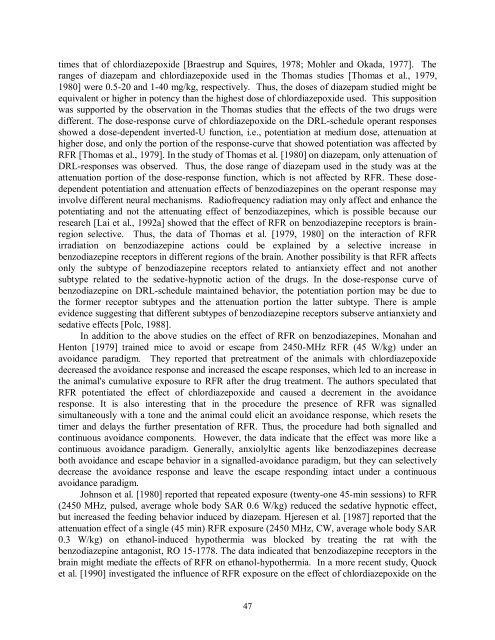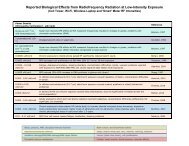Evidence for Effects on Neurology and Behavior - BioInitiative Report
Evidence for Effects on Neurology and Behavior - BioInitiative Report
Evidence for Effects on Neurology and Behavior - BioInitiative Report
Create successful ePaper yourself
Turn your PDF publications into a flip-book with our unique Google optimized e-Paper software.
times that of chlordiazepoxide [Braestrup <strong>and</strong> Squires, 1978; Mohler <strong>and</strong> Okada, 1977]. The<br />
ranges of diazepam <strong>and</strong> chlordiazepoxide used in the Thomas studies [Thomas et al., 1979,<br />
1980] were 0.5-20 <strong>and</strong> 1-40 mg/kg, respectively. Thus, the doses of diazepam studied might be<br />
equivalent or higher in potency than the highest dose of chlordiazepoxide used. This suppositi<strong>on</strong><br />
was supported by the observati<strong>on</strong> in the Thomas studies that the effects of the two drugs were<br />
different. The dose-resp<strong>on</strong>se curve of chlordiazepoxide <strong>on</strong> the DRL-schedule operant resp<strong>on</strong>ses<br />
showed a dose-dependent inverted-U functi<strong>on</strong>, i.e., potentiati<strong>on</strong> at medium dose, attenuati<strong>on</strong> at<br />
higher dose, <strong>and</strong> <strong>on</strong>ly the porti<strong>on</strong> of the resp<strong>on</strong>se-curve that showed potentiati<strong>on</strong> was affected by<br />
RFR [Thomas et al., 1979]. In the study of Thomas et al. [1980] <strong>on</strong> diazepam, <strong>on</strong>ly attenuati<strong>on</strong> of<br />
DRL-resp<strong>on</strong>ses was observed. Thus, the dose range of diazepam used in the study was at the<br />
attenuati<strong>on</strong> porti<strong>on</strong> of the dose-resp<strong>on</strong>se functi<strong>on</strong>, which is not affected by RFR. These dosedependent<br />
potentiati<strong>on</strong> <strong>and</strong> attenuati<strong>on</strong> effects of benzodiazepines <strong>on</strong> the operant resp<strong>on</strong>se may<br />
involve different neural mechanisms. Radiofrequency radiati<strong>on</strong> may <strong>on</strong>ly affect <strong>and</strong> enhance the<br />
potentiating <strong>and</strong> not the attenuating effect of benzodiazepines, which is possible because our<br />
research [Lai et al., 1992a] showed that the effect of RFR <strong>on</strong> benzodiazepine receptors is brainregi<strong>on</strong><br />
selective. Thus, the data of Thomas et al. [1979, 1980] <strong>on</strong> the interacti<strong>on</strong> of RFR<br />
irradiati<strong>on</strong> <strong>on</strong> benzodiazepine acti<strong>on</strong>s could be explained by a selective increase in<br />
benzodiazepine receptors in different regi<strong>on</strong>s of the brain. Another possibility is that RFR affects<br />
<strong>on</strong>ly the subtype of benzodiazepine receptors related to antianxiety effect <strong>and</strong> not another<br />
subtype related to the sedative-hypnotic acti<strong>on</strong> of the drugs. In the dose-resp<strong>on</strong>se curve of<br />
benzodiazepine <strong>on</strong> DRL-schedule maintained behavior, the potentiati<strong>on</strong> porti<strong>on</strong> may be due to<br />
the <str<strong>on</strong>g>for</str<strong>on</strong>g>mer receptor subtypes <strong>and</strong> the attenuati<strong>on</strong> porti<strong>on</strong> the latter subtype. There is ample<br />
evidence suggesting that different subtypes of benzodiazepine receptors subserve antianxiety <strong>and</strong><br />
sedative effects [Polc, 1988].<br />
In additi<strong>on</strong> to the above studies <strong>on</strong> the effect of RFR <strong>on</strong> benzodiazepines, M<strong>on</strong>ahan <strong>and</strong><br />
Hent<strong>on</strong> [1979] trained mice to avoid or escape from 2450-MHz RFR (45 W/kg) under an<br />
avoidance paradigm. They reported that pretreatment of the animals with chlordiazepoxide<br />
decreased the avoidance resp<strong>on</strong>se <strong>and</strong> increased the escape resp<strong>on</strong>ses, which led to an increase in<br />
the animal's cumulative exposure to RFR after the drug treatment. The authors speculated that<br />
RFR potentiated the effect of chlordiazepoxide <strong>and</strong> caused a decrement in the avoidance<br />
resp<strong>on</strong>se. It is also interesting that in the procedure the presence of RFR was signalled<br />
simultaneously with a t<strong>on</strong>e <strong>and</strong> the animal could elicit an avoidance resp<strong>on</strong>se, which resets the<br />
timer <strong>and</strong> delays the further presentati<strong>on</strong> of RFR. Thus, the procedure had both signalled <strong>and</strong><br />
c<strong>on</strong>tinuous avoidance comp<strong>on</strong>ents. However, the data indicate that the effect was more like a<br />
c<strong>on</strong>tinuous avoidance paradigm. Generally, anxiolyltic agents like benzodiazepines decrease<br />
both avoidance <strong>and</strong> escape behavior in a signalled-avoidance paradigm, but they can selectively<br />
decrease the avoidance resp<strong>on</strong>se <strong>and</strong> leave the escape resp<strong>on</strong>ding intact under a c<strong>on</strong>tinuous<br />
avoidance paradigm.<br />
Johns<strong>on</strong> et al. [1980] reported that repeated exposure (twenty-<strong>on</strong>e 45-min sessi<strong>on</strong>s) to RFR<br />
(2450 MHz, pulsed, average whole body SAR 0.6 W/kg) reduced the sedative hypnotic effect,<br />
but increased the feeding behavior induced by diazepam. Hjeresen et al. [1987] reported that the<br />
attenuati<strong>on</strong> effect of a single (45 min) RFR exposure (2450 MHz, CW, average whole body SAR<br />
0.3 W/kg) <strong>on</strong> ethanol-induced hypothermia was blocked by treating the rat with the<br />
benzodiazepine antag<strong>on</strong>ist, RO 15-1778. The data indicated that benzodiazepine receptors in the<br />
brain might mediate the effects of RFR <strong>on</strong> ethanol-hypothermia. In a more recent study, Quock<br />
et al. [1990] investigated the influence of RFR exposure <strong>on</strong> the effect of chlordiazepoxide <strong>on</strong> the<br />
47



